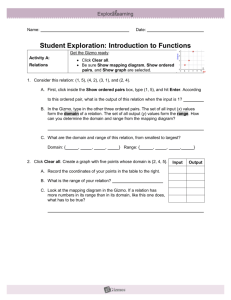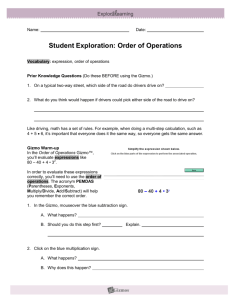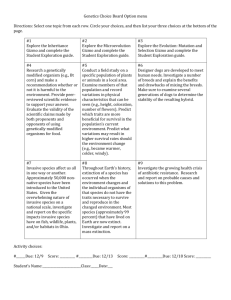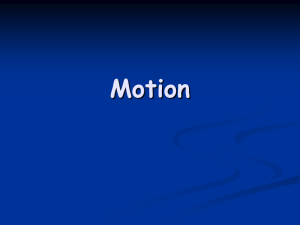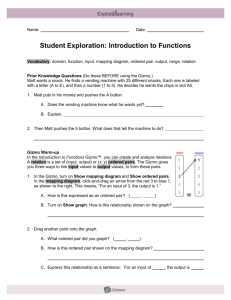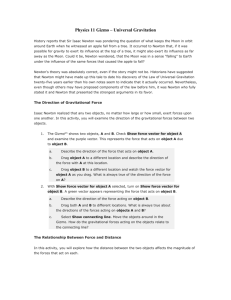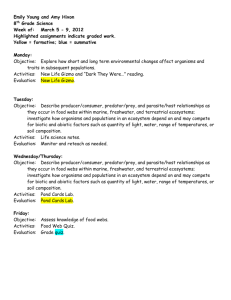Period Mass Spring.doc
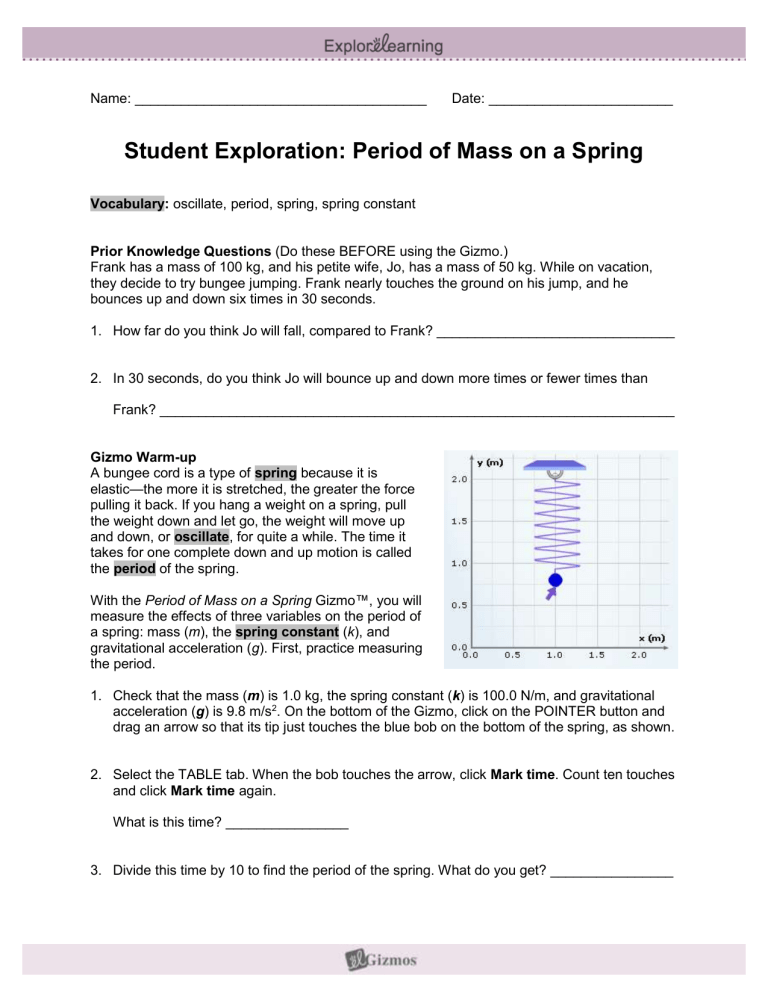
Name: ______________________________________ Date: ________________________
Student Exploration: Period of Mass on a Spring
Vocabulary: oscillate, period, spring, spring constant
Prior Knowledge Questions (Do these BEFORE using the Gizmo.)
Frank has a mass of 100 kg, and his petite wife, Jo, has a mass of 50 kg. While on vacation, they decide to try bungee jumping. Frank nearly touches the ground on his jump, and he bounces up and down six times in 30 seconds.
1. How far do you think Jo will fall, compared to Frank? _______________________________
2. In 30 seconds, do you think Jo will bounce up and down more times or fewer times than
Frank? ___________________________________________________________________
Gizmo Warm-up
A bungee cord is a type of spring because it is elastic —the more it is stretched, the greater the force pulling it back. If you hang a weight on a spring, pull the weight down and let go, the weight will move up and down, or oscillate , for quite a while. The time it takes for one complete down and up motion is called the period of the spring.
With the Period of Mass on a Spring Gizmo™, you will measure the effects of three variables on the period of a spring: mass ( m ), the spring constant ( k ), and gravitational acceleration ( g ). First, practice measuring the period.
1. Check that the mass ( m ) is 1.0 kg, the spring constant ( k ) is 100.0 N/m, and gravitational acceleration ( g ) is 9.8 m/s 2 . On the bottom of the Gizmo, click on the POINTER button and drag an arrow so that its tip just touches the blue bob on the bottom of the spring, as shown.
2. Select the TABLE tab. When the bob touches the arrow, click Mark time . Count ten touches and click Mark time again.
What is this time? ________________
3. Divide this time by 10 to find the period of the spring. What do you get? ________________
Get the Gizmo ready:
Activity A:
Mass
Click Reset . Set m to 0.2 kg.
Check that k is 100 N/m and g is 9.8 m/s 2 .
Question: How does mass affect the period of a spring?
1. Predict: How do you think increasing mass will affect the period of a spring? ____________
_________________________________________________________________________
2. Gather data: Adjust the arrow to mark the bottom of the spring’s motion. For each given mass, measure the time for ten oscillations and divide this number by 10 to find the period.
(Keep k set to 100 N/m and g set to 9.8 m/s 2 in each experiment.)
m (kg)
Time for 10 oscillations
Period (s)
Square root of mass (m)
Period
Sq. rt. Mass
0.2 kg
0.4 kg
0.8 kg
1.8 kg
3. Observe: In general, how does increasing the mass affect the period of the spring? _______
_________________________________________________________________________
4. Analyze: Divide the period for the 0.8 kg mass by the period for the 0.2 kg mass.
A. What is the effect of multiplying the mass by 4? _____________________________
B. Divide the period for the 1.8 kg mass by the period for the 0.2 kg mass. What is the effect of multiplying the mass by 9? _______________________________________
5. Calculate: Calculate the square root of each mass and fill in the fourth column. Then, divide each period by the square root of the mass to fill in the last column.
What do you notice about these ratios? _________________________________________
6. Make a rule: When k is 100 N/m and g is 9.8 m/s 2 , how can you calculate the period given the mass? ________________________________________________________________
Activity B:
The spring constant
Get the Gizmo ready:
Click Reset . Set m to 1.0 kg.
Set k to 50 N/m and check that g is 9.8 m/s 2 .
Introduction: The spring constant is a measure of the stiffness of a spring. The greater the spring constant, the greater the force required to stretch or compress the spring.
Question: How does the spring constant affect the period of a spring?
1. Predict: How do you think increasing the spring constant will affect the period of a spring?
_________________________________________________________________________
2. Gather data: Adjust the arrow to mark the bo ttom of the spring’s motion. For each given mass, measure the time for ten oscillations and divide this number by 10 to find the period.
(Keep m set to 1.0 kg and g set to 9.8 m/s 2 in each experiment.)
k (N/m)
Time for 10 oscillations
Period (s)
Square root of spring constant (k)
Sq. rt. k × Period
50 N/m
100 N/m
150 N/m
200 N/m
3. Observe: In general, how does increasing the spring constant affect the period of the spring? ___________________________________________________________________
4. Analyze: Divide the period for the 200 N/m spring by the period for the 50 N/m spring. What is the effect of multiplying the spring constant by 4? ________________________________
_________________________________________________________________________
5. Calculate: Calculate the square root of each spring constant. Then, multiply each of these values by the corresponding period. What do you notice about these products?
_________________________________________________________________________
6. Make a rule: When m is 1.0 kg and g is 9.8 m/s 2 , how can you calculate the period given the spring constant? ___________________________________________________________
Activity C:
Gravitational acceleration
Get the Gizmo ready:
Click Reset .
Set m to 1.0 kg, k to 100 N/m, and g to 5.0 m/s 2 .
Question: How does gravitational acceleration affect the period of a spring?
1. Predict: How do you think increasing gravitational acceleration ( g ) will affect the period of a spring? ___________________________________________________________________
2. Gather data : Adjust the arrow to mark the bottom of the spring’s motion. For each given mass, measure the time for ten oscillations and divide this number by 10 to find the period.
g (m/s 2 ) Time for 10 oscillations Period (s)
5.0 m/s 2
10.0 m/s 2
15.0 m/s 2
3. Draw conclusions: Based on your data, what is the effect of gravitational acceleration on the period of a spring? __________________________________________________________
_________________________________________________________________________
4. Summarize: Review what you learned about the effects of mass and the spring constant on the period of a spring. Use what you have learned so far to fill in these sentences:
If the spring constant is 100 N/m, the period is equal to the _____________
_____________ of the mass multiplied by _____________.
If the mass is held constant at 1.0 kg, the period is equal to ____________ divided by the _____________ _____________ of the spring constant.
5. Make a rule: Complete the formula for the period of a spring below. The symbol T stands for the period of the spring. Use the Gizmo to test your formula to make sure it works.
T
2
